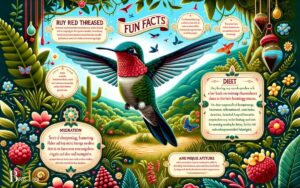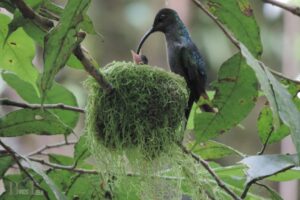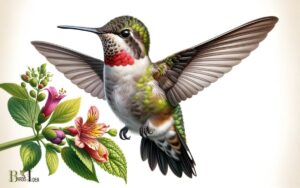Allen’s Hummingbird Fun Facts: A Small Bird!
Allen’s Hummingbird (Selasphorus sasin) is a small bird native to the coastal regions of western North America. Known for its remarkable flying abilities and vibrant colors, it is a favorite among birdwatchers.
Allen’s Hummingbird (Selasphorus sasin) is a small, vibrant bird native to the coastal regions of western North America.
Known for their agility and speed, these birds possess a number of interesting characteristics:
Allen’s Hummingbird plays a critical role in pollination, showcasing the interconnectedness of ecosystems.

Key Takeaway
11 Attributes of Allen’s Hummingbird Characteristics
| Attribute | Description |
|---|---|
| Scientific Name | Selasphorus sasin |
| Length | 3 to 3.5 inches |
| Weight | Approx. 3 grams |
| Wingspan | Approx. 4 inches |
| Lifespan | Up to 4 years in the wild |
| Habitat | Coastal regions, chaparral, and oak woodlands |
| Range | Western North America, mainly California |
| Diet | Nectar, small insects, and spiders |
| Breeding Season | February to May |
| Clutch Size | Typically 2 eggs |
| Conservation Status | Least Concern, but habitat loss is a potential threat |
Allen’s Hummingbird Habitat
The Allen’s hummingbird is found in the coastal regions of Oregon and California, as well as in the western parts of the United States and Canada.
These tiny birds prefer habitats with a mix of open spaces and forested areas, often residing in coastal scrub, chaparral, oak woodlands, and riparian areas. They are also known to inhabit gardens and parks, especially those with an abundance of nectar-producing flowers.
The mild coastal climate of these regions provides an ideal environment for the Allen’s hummingbird, offering a consistent supply of nectar and small insects for their diet.
This diverse range of habitats allows them to thrive in various landscapes, making them a common sight for birdwatchers and nature enthusiasts.
Unique Physical Characteristics
Exhibiting distinct physical features, Allen’s hummingbirds possess unique traits that distinguish them from other bird species inhabiting their coastal environments.
Thriving in the diverse range of habitats previously mentioned, they have adapted specific physical characteristics to navigate and thrive in these varied landscapes.
- Exceptional Agility: Their small size and unique wing structure allow them to hover, fly backward, and change direction swiftly, enabling them to access nectar from intricate flowers.
- Iridescent Plumage: The bright, iridescent feathers of the male Allen’s hummingbird reflect vibrant colors in the sunlight, making them visually striking during courtship displays.
- Specialized Beak: Their slender, elongated beaks are perfectly adapted for reaching deep into flowers to extract nectar, providing them with the necessary sustenance.
- Energetic Behavior: Allen’s hummingbirds are known for their swift movements and distinctive vocalizations, adding to their charismatic appeal.
Intriguing Feeding Behavior
Allen’s hummingbirds exhibit intriguing feeding behavior, showcasing their specialized adaptations for obtaining nectar from various flowers.
Their unique physical characteristics, such as a long, slender bill and a specialized tongue, enable them to access nectar from deep within flowers. These birds have the ability to hover in mid-air, allowing them to feed from flowers while in flight.
Their rapid wingbeats, averaging around 50 times per second, facilitate their ability to hover and maneuver with precision around flowers.
In addition to nectar, Allen’s hummingbirds also consume small insects and spiders for essential proteins and nutrients.
Their feeding behavior is not only fascinating to observe but also crucial for their survival, as they must consume large amounts of nectar and small prey to meet their high energy demands.
Impressive Mating Rituals
Impressing potential mates with elaborate aerial displays, the Allen’s hummingbird’s mating rituals are a sight to behold.
These tiny birds engage in remarkable behaviors to attract a mate, including:
- Diving displays: Males perform steep U-shaped dives, reaching speeds of up to 60 miles per hour before pulling up just before reaching the ground.
- Zigzagging flights: Males showcase their agility and speed by darting back and forth in a zigzag pattern, creating a mesmerizing visual display.
- Duet singing: Both males and females participate in elaborate duet singing, producing intricate and synchronized vocalizations to communicate their readiness to mate.
- Tail feather displays: Males use their iridescent gorget and tail feathers to create dazzling visual effects, catching the sunlight and creating vibrant displays to attract a mate.
These astonishing mating rituals highlight the beauty and complexity of Allen’s hummingbirds.
Conservation Efforts
Efforts to conserve the Allen’s hummingbird population have become increasingly imperative due to the impact of human activity on their natural habitats. These beautiful creatures face threats such as habitat loss, pesticide use, and climate change.
Conservationists and organizations are working diligently to protect and preserve the Allen’s hummingbird through various initiatives including habitat restoration, public awareness campaigns, and research efforts.
Here’s a summary of some ongoing conservation efforts:
| Conservation Efforts | Description | Impact |
|---|---|---|
| Habitat Restoration | Replanting native flora and creating protected areas to provide suitable habitats for the birds | Preserves natural habitats |
| Public Awareness | Educating communities about the importance of preserving hummingbird habitats | Encourages support and action from the public |
| Research Initiatives | Studying behavior, migration patterns, and nesting habits to inform conservation strategies | Provides valuable data for targeted conservation |
These efforts play a crucial role in ensuring the continued survival of the Allen’s hummingbird population.
Where Do Allen’s Hummingbirds Live?
Allen’s hummingbirds (Selasphorus sasin) are primarily found along the western coast of North America, ranging from southern Oregon to Baja California in Mexico. These tiny, vibrant birds prefer habitats such as coastal scrublands, chaparral, and oak woodlands, often nesting in shrubs and trees near open areas with abundant flowers for nectar.
They are particularly drawn to gardens, parks, and suburban areas with flowering plants.
Due to their migratory nature, Allen’s hummingbirds can also be spotted during their seasonal movements, traveling to breed in more northern regions during the summer months and returning to warmer climates in the winter.
Their adaptability to urban environments has made them a common sight in backyard feeders and urban green spaces throughout their range.
- Allen’s hummingbirds thrive along the western coast of North America.
- They prefer habitats such as coastal scrublands, chaparral, and oak woodlands.
- These birds nest in shrubs and trees near areas abundant in flowering plants.
- They are commonly found in gardens, parks, and suburban areas.
- Allen’s hummingbirds migrate seasonally, breeding in northern regions during summer and returning to warmer climates in winter.
Conclusion
Allen’s Hummingbird is a fascinating species with a unique habitat, physical characteristics, feeding behavior, and mating rituals.
Conservation efforts are important to ensure the survival of this remarkable bird. Their ability to hover in mid-air is simply mind-blowing, making them a true marvel of the avian world.
It is essential that we continue to protect and preserve their natural environment for future generations to enjoy.






